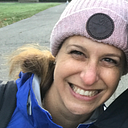Good Points / Nekudot Tovot
Nekudot Tovot is a practice from the Chassidic teacher Rabbi Nachman of Breslov. The practice teaches us to locate the “good points” in someone or something. I learned about this practice through my Mussar and Jewish spirituality exploration with The Inside Out Wisdom and Action Project (IOWA).
*****
When I taught middle school, a stencil sketch of Che Guevara’s face hung in my classroom, along with his words: “Let me say, at the risk of seeming ridiculous, that the true revolutionary is guided by great feelings of love.”
I think about the love that meaningful transformation requires. It’s a love that has nothing to do with sweetness or softness. The love that undergirds transformation is fierce. It’s unrelenting in its tenderness, unflinching in its clarity. It takes in not just a part, but the whole.
The whole.
The first thing we learned in craniosacral therapy training was to listen for health. As I sit at the ankles of my clients, grounding into my own field and inviting theirs to show as it wants, I invite with my intention, “Would you like to show me your health?”
Often, the body responds right away. It shows up in multiple forms — a “whoosh” feeling through the front body; a tingling in the soles of the feet; a releasing of the sacrum deeper into the table; a lightness in the space around the body; an opening in the thoracic cavity that cradles a full exhale.
As humans in a US-American context who navigate a system of white supremacy, heteropatriarchy, Christian hegemony and a version of capitalism that’s built by stolen bodies on stolen land, we’re not conditioned to notice health. In fact, we’re conditioned against noticing health. We’re conditioned instead to notice the pain, the sins, the ways in which we and others don’t measure up. This often clouds our ability to be with what’s also here: the health, the joy, the good points.
When I first learned of the Nekudot Tovot (Good Points) practice it struck me as trite. I was orienting to the practice in terms of either/or thinking — either be with the negative or the positive. It reminded me of “look on the bright side” or “what’s the silver lining” or anything else that gets offered to placate rather than witness.
What broke this open for me was when Rabbi Stillman shared that this practice was born from a rabbi who was intimately familiar with despair.
Sometimes my grief, rage and fear feel overwhelming. They’ve often been too big to feel, so I’ve managed to survive around them — one way that I override them is through giving of myself beyond my own boundaries. This override has helped me survive. Because when I’m with the truth of all the all, the pain of the world as it is, the dissonance between what’s true and what’s just, it is jarring.
Learning that the practice of Nekudot Tovot was born from despair felt like coming home, sitting at the feet of elders and being told in no uncertain terms to notice it all because if we don’t then we (and here the “we” is the collective, the earth, everything that breathes) simply won’t make it, and we certainly won’t thrive.
Rabbi Stillman shared with our va’ad (Mussar and Jewish spirituality practice group) the words of Etty Hillesum to illustrate Nekudot Tovot in action. Hillesum, a Dutch author who was murdered as a young adult in the Holocaust, writes in a book called An Interrupted Life and Letters from Westerbork:
The misery here is quite terrible; and yet, late at night when the day has slunk away into the depths behind me, I often walk with a spring in my step along the barbed wire. And then time and again, it soars straight from my heart — I can’t help it, that’s just the way it is, like some elementary force — the feeling that life is glorious and magnificent, and that one day we shall be building a whole new world.
And again, from Westerbork:
The sky is full of birds, the purple lupins stand up so regally and peacefully, two little old women have sat down for a chat, the sun is shining on my face — and right before our eyes, mass murder… The whole thing is simply beyond comprehension.
The wholeness is so often simply beyond comprehension.
Last month, supporters of our outgoing president stormed the Capitol and attempted a coup. When I saw images of this my system went into a fog and freeze. I felt too tired to chase after focus, too foggy to complete tasks, and unable to find the words for any of it. Sometimes, in moments like these, when loved ones ask me how I’m doing, I can tell them in colors — last week was burnt orange and all the shades of gray that exist.
Today, when the answer to how I’m doing is a downward gray paint stroke on a dirty canvas, I remind myself to lean gently into the practice of Nekudot Tovot. So now I share with you the good points from this afternoon, from a couple hours spent on the sledding hill — the small brown maple leaf that remained whole atop the ice; the noise and bumps and wind and twinge of excitement and fear as I sped down the hill; the way my sunglasses gave everything a yellow warm tint; hand-warmers in gloves; big kids carrying little ones’ sleds up the hill; the smile on my daughter’s face when she got air from the ice jump; the cheers of delight when my son and his friend did the same.
Naming the joy in the face of despair, noticing the good points when we’ve been conditioned to overlook them, being with the truth of our own health alongside the truth of our own pain, this is the wholeness that this practice demands. And this, to me, is revolutionary.
